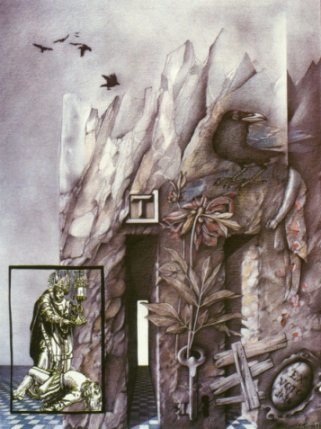The Symbolism of Epilepsy
Karlheinz Geier (1983), drawing
From early times, human beings have attempted to portray things that are inconceivable, incomprehensible, inexplicable, abstract, using signs, symbols and metaphors, and the symbolism of epilepsy has played a significant role throughout the centuries. The often dramatic manifestation of this disease, the mostly futile attempts to treat the illness in earlier centuries, the effects on the psychological and social situation of epileptic people and their families, and the unrealistic and superstitious ideas about the causes of the disease which developed in the different ages,  have always led people to portray the 'theme' epilepsy in metaphors and symbols.
have always led people to portray the 'theme' epilepsy in metaphors and symbols.
In this drawing, epilepsy is represented as a high, dangerous, insurmountable mountain range which bars the way (of life) of the person with epilepsy. Ravens, the symbol of the devil, of evil spirits and disease-bringing demons, fly round the mountains. Futile attempts at treating the disease are also suggested in the picture: an exvotive tablet, Saint Valentin, the most important patron saint of the falling sickness, attempting to heal epilepsy (famous woodcut by Lucas Cranach, from 1509); the peony, whose parts (leaves, stem, petals, roots, seeds) were believed in ancient Greek and Roman times to be a cure for the disease; the key with which the clamped jaws and the stiff limbs of the person having a seizure could be 'unlocked' ('Fraisenschlüssel' - convulsion key); the corpse of someone who had been hanged (as early as Roman times, the Middle Ages, and into the 19th century, the blood of people who had been executed was regarded to be an 'excellent remedy for the falling sickness'). All measures did nothing to ward off the dreaded illness, the way through the 'mountains of disease' remained blocked, nailed up (between the key and the exvotive tablet). And yet, there is a glimmer of hope, an unblocked path hints at a light at the end of the tunnel. A large 'T' is written over the top, perhaps a symbol for modern, scientifically based epilepsy therapy.
--- close this window ---